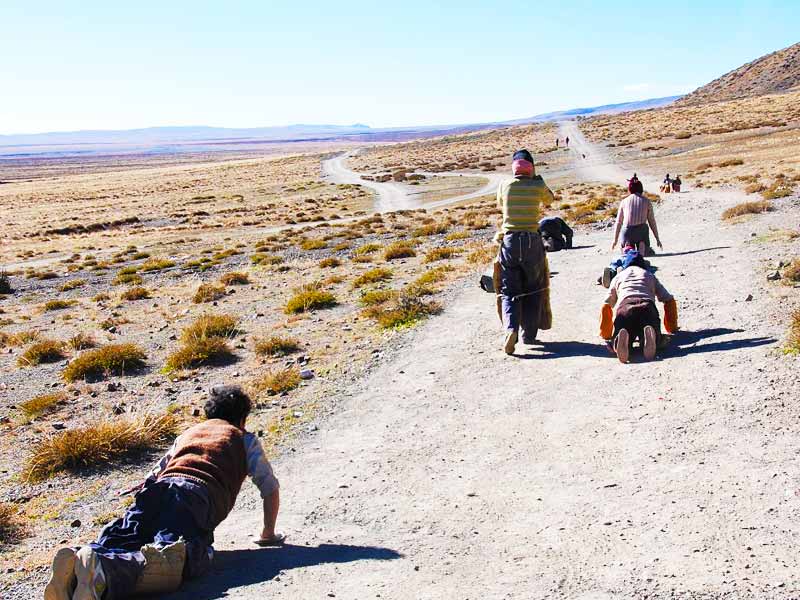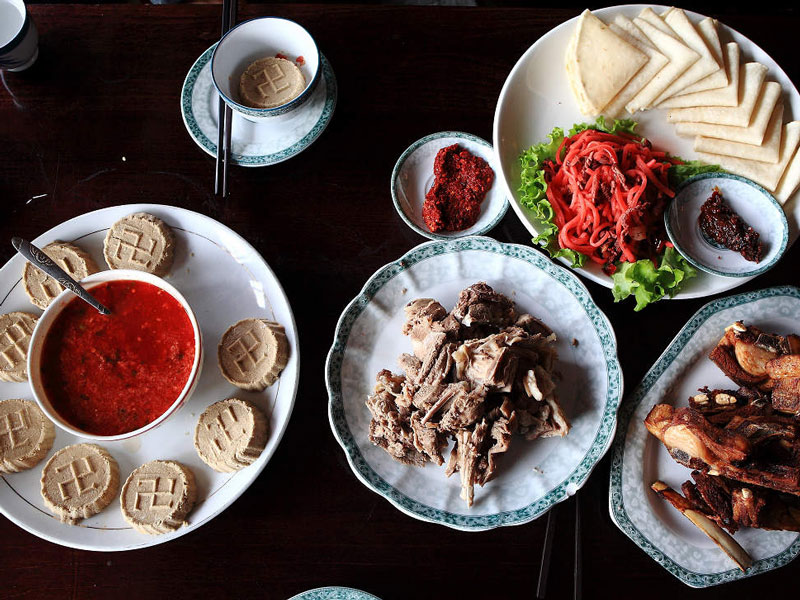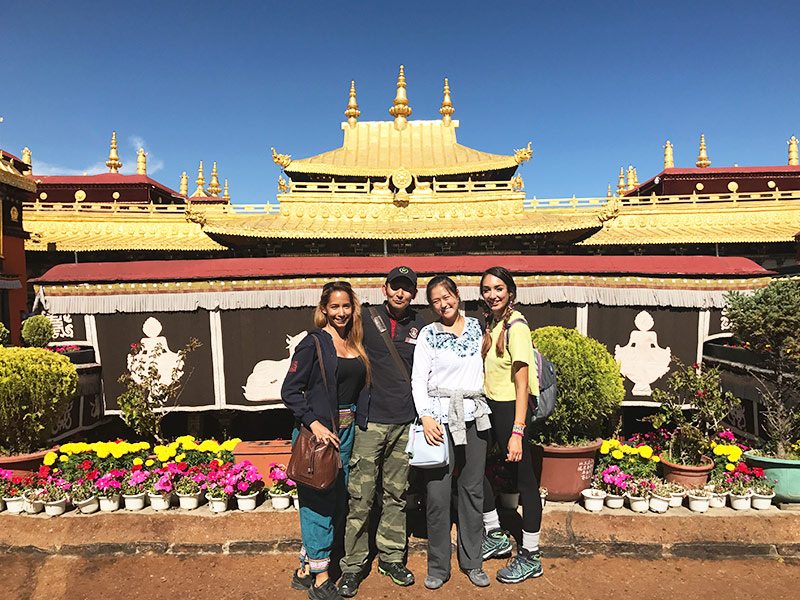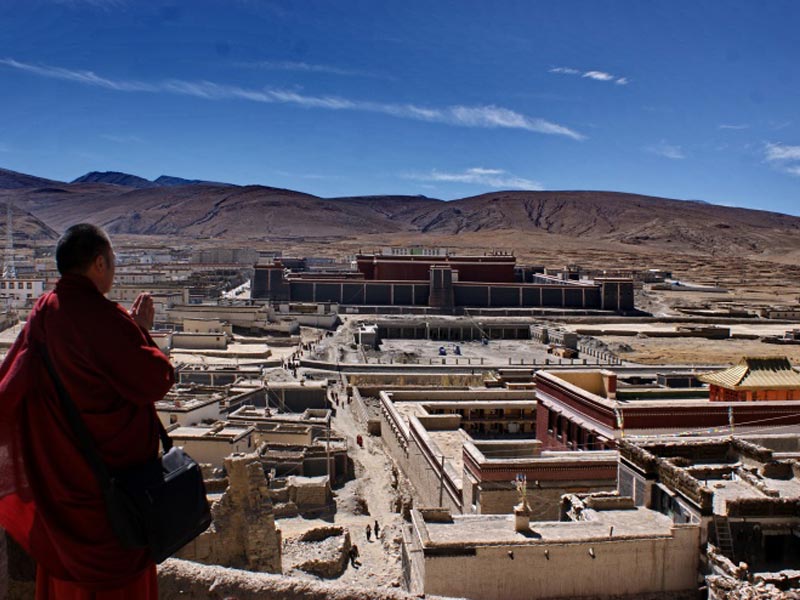Kora is a Tibetan word which literally in English means ‘circumambulation’ or revolution. Kora also refers to the act of showing reverence to the holy aspects of the world that the Tibetans believe to be holy and sacred. It is not only a form of pilgrimage but also meditation and a way of enlightenment. It is mainly done by the circumnavigation of the sacred aspect in a clockwise direction. Many things like mountains, monasteries and lakes are considered to be holy in Tibet.
Kora is considered to be an important part of any festival, holy ritual and also pilgrimage. Distinct kora routes are also constructed in places where accessibility otherwise would have been impossible. The kora usually takes place between dawn and dusk, though in some holy rituals it might continue for a longer time.
During the circumnavigation in the clockwise direction, the pilgrims chant mantras and rotate their prayer wheels. Not only that, they also perform prostration in front of the holy aspects sometimes while performing the kora. Thus kora is a performance that is intricately embellished in the lives of not only Tibetan pilgrims but also in the lives of the normal people living in Tibet.
The main significance of kora is the emotion of fulfillment that it generates within a pilgrim. According to a pilgrim, a perfect kora will make him understand the divine power better. Not only that, it will take him move closer to his ultimate aim of attainment of enlightenment.
Kora is very important in a pilgrim’s life as it helps him to leave behind the material attractions and lay his life to the attainment of divinity. While performing the kora in the serenity of nature, along with the humming of the mantras, the pilgrims are able to meditate perfectly and attain knowledge. They also believe that performing kora in the purest form is an aspect of showing utmost reverence to God. Thus they often indulge in kora, especially in the koras that are bit difficult to thank god for providing them with a bounty life and a life full of love. Thus kora holds these importances in the lives of the pilgrims.
Why Kailash Kora
Mount Kailash is considered to be an extremely sacred spot not only by the Tibetans, but also by the whole world. It is roughly a kora involving a distance of 52 kilometers at an elevation of 5000m. Thus it is considered to be one of the most challenging koras in Tibet. It is because of the challenging path that it has become so popular. Also the kora around Mount Kailash is a tradition dated back to as many as thousand years ago. The pilgrims believe that circumnavigating Kailash will bring them good fortune and enlightenment. The kora includes the magnificent Mount Kailash and also the spectacular lake Manasarovar that is also a very holy spot.
Probably, in Tibet, Mount Kailash is the holiest spot as it is the abode of deity Chakrasamvara that requires quite a hard work to achieve. Thus the pilgrims from not only Tibet but also from other parts of the world are inclined to complete this kora. This is popular because the achievement of Mount Kailash kora is considered to be a holiest aspect that can be achieved in a pilgrim’s life.
But besides the kora, the trek route inspires and excites many trekkers also. The trek occurs at an extremely high altitude that involves some extremely high altitude passes and difficult roads to cross. Thus the Kailash kora being a famous kora attracts not only pilgrims but also trekkers.
Four Routes to Mount Kailash
The different four routes to Mount Kailash via Lhasa, Kashgar, India and Nepal are as follows-
Lhasa to Mount Kailash
The trek or the Mount Kailash kora generally starts from Lhasa. From Lhasa, people drive to Shigatse via Gyantse. Then from Gyantse to Everest Base Camp and Saga and from there to Darchen. Then from Darchen, the outer kora starts via three monasteries namely Chuku, Drirupuk, Zutulpuk. After that, also from Darchen, the inner kora journey will start and it continues until one reaches the foot of Kailash Mountain via Selong Gompa and Gyangdrak Gompa. This is mainly known as the southern route. The southern route is the most popular route. The distance of Kailash from Lhasa is about 1400km. There is another way to visit Mount Kailash from Lhasa that is by the northern route leading to Shiquanhe.
Kashgar to Mount Kailash
Kashgar to Mount Kailash is a long and hectic journey. You have to start your journey from Kashgar, the largest oasis of China and travel to Yechang. Then from Yechang, you have to travel to Mazar, having a distance of 234 km. Then from Mazar, begin your journey to Dhongliutan which will take about 8-9 hours having a distance of 358km. Then from Dhongliutan to Durma and finally to Ali. You have to travel from Ali to Zanda and then to Darchen via driving. The distance between Zanda and Darchen is about 228 km and it will take six to seven hours to drive there. Then from Darchen, you can continue your journey to Kailash via trekking.
India to Kailash
If you want to travel to Kailash from India, then first you have to visit Tibet. Since there is no direct international flight between Tibet and India, tourists can either travel from India to Nepal and later take flight from Kathmandu to Lhasa or fly directly from India to Beijing and later take Beijing-Lhasa train to Tibet. Then, gradually travel from Lhasa to Shigatse and Saga to visit holy Manasrovar Lake and Mt. Kailash. If you opt for travelling from Nepal to Tibet, you have to rely on a travel agency to help you get “Group Tourist Visa” and Tibet Travel Permit.
Nepal to Mount Kailash
Many tourists go to visit Mount Kailash from Kathmandu, capital of Nepal. Travelers can fly from Kathmandu to Lhasa and then drive to Mt. Kailash along the southern route. Besides, tourists can travel overland from Nepal to Tibet. Drive along the Sina-Nepal Highway from Gyirong to Tingri and then turn west to Kailash along the Xinjiang-Tibet Road. On the way, travelers can pay a visit to the holy Lake Manasarovar or make a detour to Mt. Everest, the world’s highest peak.
Outer and Inner Kora Routes of Mount Kailash
Mount Kailash kora consists of two distinct kora routes namely the inner kora and the outer kora routes. Both the outer and inner kora routes begin at Darchen.
Mount Kailash Outer Kora Route
The outer kora of Mount Kailash involves a journey of 56km. It includes a journey of three days and night stays in Drirapuk and Zutulpuk monasteries on the way. Usually pilgrims doing prostration takes three to four days to complete a circle whereas there are some pilgrims who complete a circle as fast as a day. The outer kora route constitutes of –
• The first day of outer kora involves a trek from Darchen to Drirapuk. The total time taken will be 12 hours and the distance is about 13km. Overnight staying in Drirapuk monastery is advised. The accommodation is basic and the food is simple.
• The second day, trekking begins from Drirapuk monastery to Zutulpuk monastery. The distance covered will be about 18km and the time taken will be 12 hours.
• The third day, you have to trek back to Darchen from Zutulpuk monastery. The distance covered will be 7km and the time taken will be 12 hours.
Mount Kailash Inner Kora Route
The inner kora route of Mount Kailash is comparatively harder than the outer kora route. The inner kora route leads to the southern face of Mount Kailash directly. The inner kora route is –
As for the 30-kilometer-long inner circuit, you would start from the north of Darchen tracing back the river and turn left at the intersection. Then arrive at Selong Gompa and trek along the west of Mt.Yinjietuo till the foot of saint mountain where you can see the natural swastika formed by big ice cracks on the south face of Mt.Kailash and rock bed traces at the hillside.
Just right above the ice tongue, hundreds of thousands of prayer flags are fluttering in the wind. And the 13 golden chortens (over 5,800m) come into view, where relics of the former Gyangdrak administrators were enshrined. Here are many meditation caves too. If possible, you can continue moving forwards along the slope and there is a 100-meter-high cliff in the end. You should be careful and do not try hard.
After the worship, you can trace down from the east face of Mt.Yinjietuo,go back to Selong Temple along the valley. The two glacier lakes en route is said to have black water in one and white in another. Move east towards the 5300-meter-high pass and then reach Gyangdrak Gompa which has been found in the early thirteenth century as the first monastery in Mt.Kailash region.After that, return to Darchen directly.
One day is enough for the whole inner circuit. It’s said that only the pilgrims who have completed 13 rounds of outer circuits are qualified for the inner one. And the inner kora of Mount Kailash is not open to international tourists so far.
Best Time to Make Kailash Kora
It is a perceived belief that if a pilgrim indulges in kora in the 15th of April of the Tibetan calendar, the kora fulfills his wishes in a better way and helps him to attain enlightenment faster. This belief has persisted probably because it is the day Sakyamuni attended Nirvana.
Nonetheless the best time to make Kailash kora is from May to September when the weather remains comfortable and perfect. In the other time, due to excessive windy and chilly weather and also excessive snowfall, the kora becomes impossible to complete.
What to Pack
Packing for Kailash kora should be done very carefully. Some of the things which you can pack for the kora are-
• Enough warm woolen clothes like woolen coats, trousers, woolen socks, and gloves.
• Choose a proper hiking shoe with lots of grip and spikes underneath to prevent you from slipping.
• Take cotton clothes and under garments along with cotton socks.
• Take torches and a walking stick with you.
• Take all your medicines.
• Take lots of mineral water bottles and dry foods like chocolates and fruits and also packed instant noodles.
• Take windproof and waterproof clothes and flannels owing to the whimsical weather. Also pack waterproof and windproof and strong tents with you.
• Do try to take porter animals like Tibetan yaks and horses.
• Do take a well knowledgeable guard with you.
• Positively keep sunglasses and sunscreens with you. You can also keep goggles, they are better to combat the extreme sunlight.
• Keep all the documents like Tibet Travel permit and the Alien Travel permit with you.
Day by Day Itinerary of Mount Kailash Kora
An itinerary of the fifteen day Kailash trek is as follows –
Day 1-3 Lhasa Tour – Potala Palace, Johkang Temple, Barkhor Street, Drepung and Sera Monastery
The journey begins for Lhasa. Arrive Lhasa and stay for few days. Enjoy the famous tourist spots like Potala palace, Jokhang temple, Barkhor street, Drepung and Sera monastery. Acclimatize your body for these three days and take enough rest.
Day 4 Lhasa- Shigatse via Gyantse (360km)
After spending two days in Lhasa, visiting the famous Drepung monastery and the Sera monastery and other famous places, start your journey for Shigatse via Gyantse. The total distance covered will be about 360 km. On this route, you will come across some of the best scenic charms of Tibet namely Yamdrok tso lake, Mount Nyenchen Khangsar, Karola glacier and other such exotic places. After resting in Gyantse for a while and reaching to Shigatse, take rest for the entire day. Stay overnight in Shigatse.
Day 5 Shigatse to EBC (350 km)
Next day, visit the famous Tashilhunpo monastery and soak in the authentic Tibetan religious charm. Then start your journey for Everest Base Camp. The total distance covered will be 350 Km. You will pass through the famous Tsola pass and the Gyatsola pass. Camping is done at Everest Base Camp region.
Day 6 EBC–Saga (450km)
Next day, before beginning your journey to Saga, do not forget to experience the sunrise on the Mount Everest. Then start your journey to Saga. The total distance covered will be about 45o km. Stay in a guesthouse for the night.
Day 7 Saga to Darchen, via Lake Manasarover (450km)
Then the next day, start your journey from Saga to Darchen, via lake Manasarovar. The journey will include a distance of 450 km. On the way, you will witness the splendid view of Saga valley. You will also see Mount Naimonanyi specifically when you will be passing through the Mayomla Pass. Then finally you will arrive at the southern foot of Mount Kailash on crossing the sacred lake Manasarovar. Try to settle in a local guesthouse for the night.
Day 8 Darchen-Drirapuk (driving 7km, Trek 13km)
The next day, the real kora will start. First you have to reach Drirapuk monastery from Darchen. On the way, you will come across the famous Sarshung village. From Sarshung your trek will finally begin. The trekking distance will be some 13km to Drirapuk monastery, via the Lachu valley. Stay in the monastery or some local guesthouse for the night.
Day 9 Drirapuk-Dzutrpuk (Trek 18km)
Next day the trek will comprise of a journey of 18km from Drirapuk to Zutulpuk. This is said to be the outer kora. On the way you will pass through the famous Dromala pass. The route is the highest of all the other kora routes. You will also see the beautiful Kadoe lake. Stay in local guesthouse.
Day 10 Dzutripuk-Darchen (Trek 7km, driving 5km)
On the day three of the kora,you will trek 7km to Zongto where you can take bus to Darchen. Along the Kora, you can see piles of Mani Stones. We will end the Trek around noon and rest in the lodging place.
Day 11-15 Get back to Lhasa
Make preparations to go back to Lhasa from Darchen.
Thus the complete guide to kora in Kailash has been provided in this article. Do not forget to contact our travel consultants to customize the details of your Lhasa to Mt.Kailash tour.
.jpg)

















0 Comment ON "Complete Guide to Tibetan Kailash Kora"